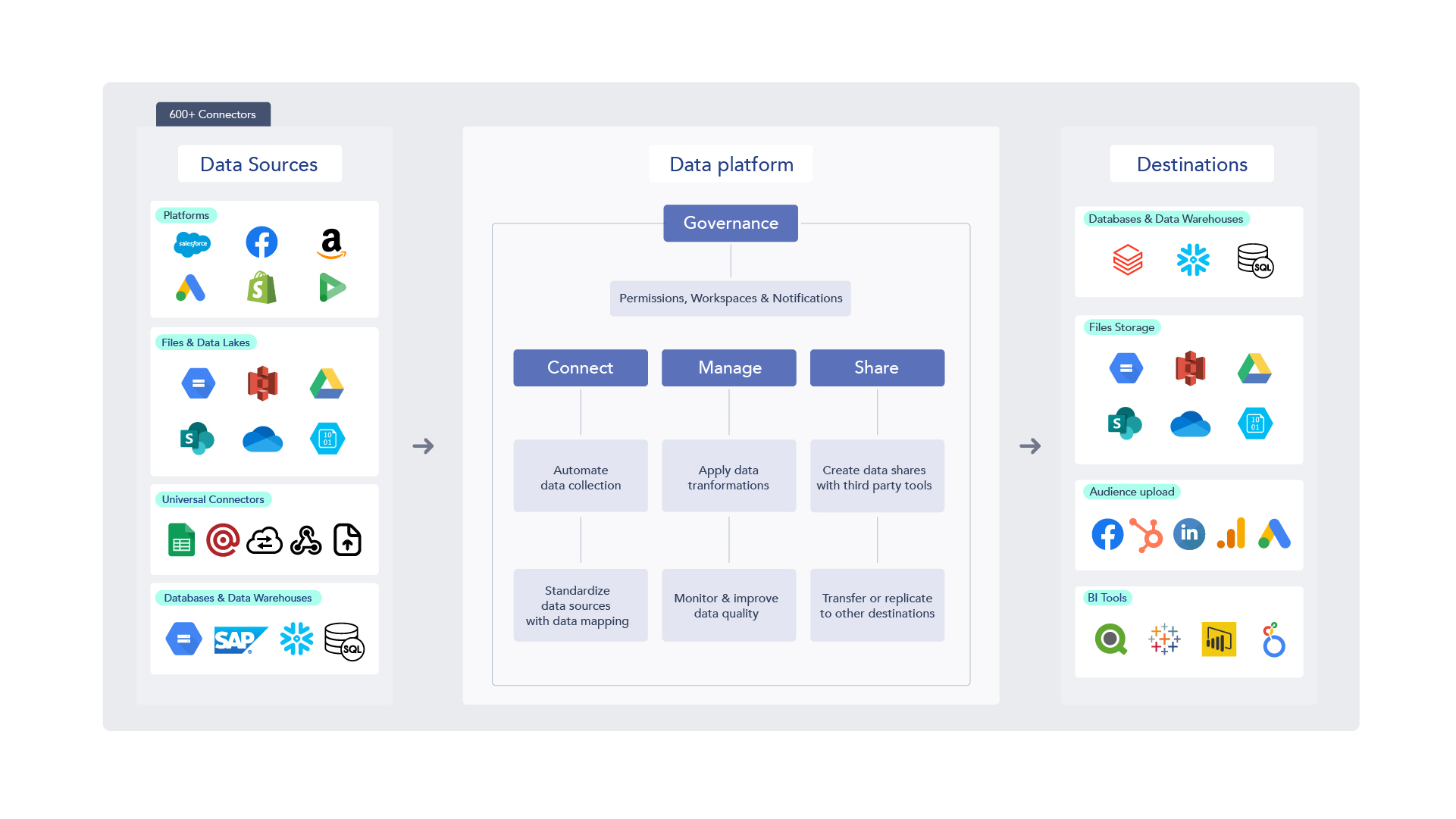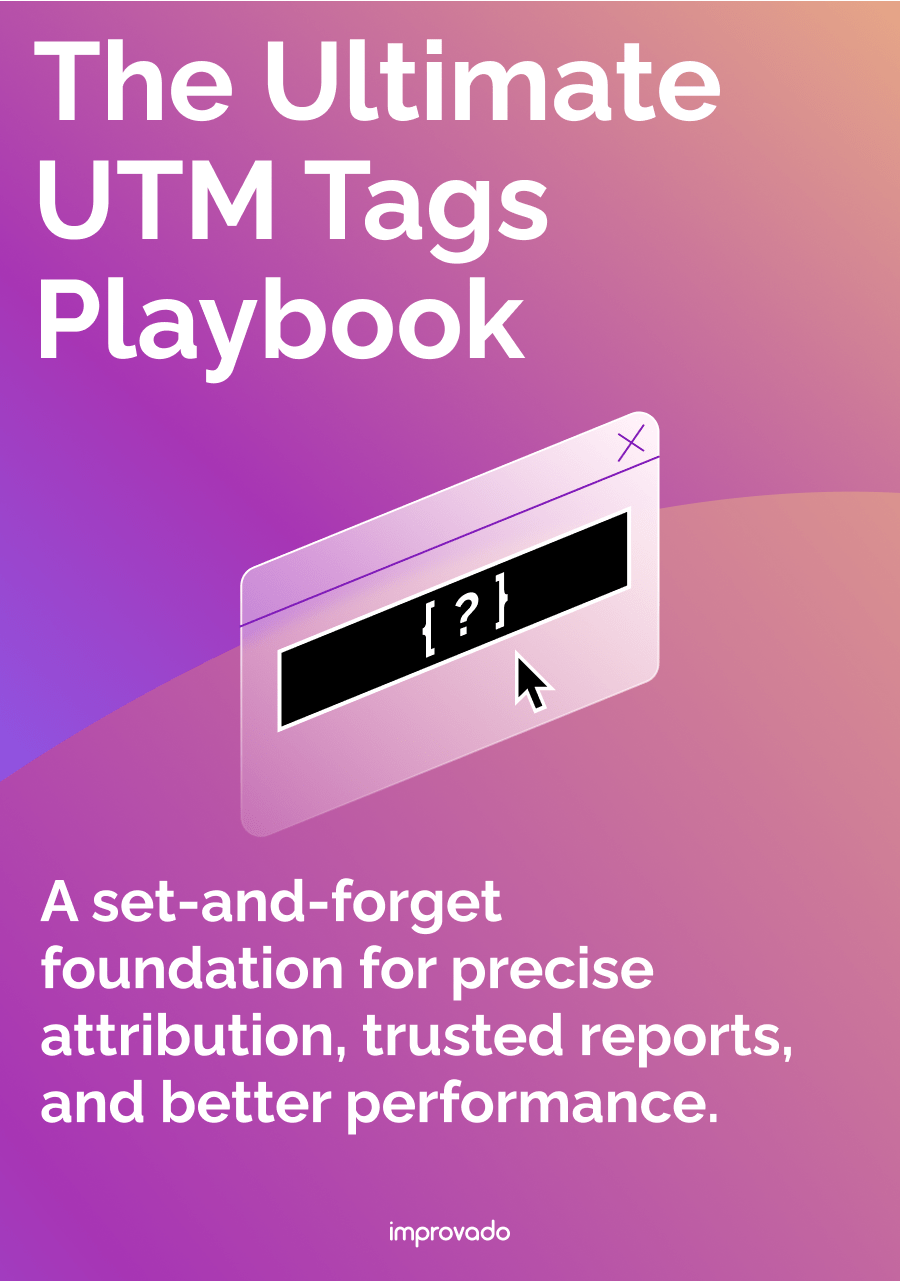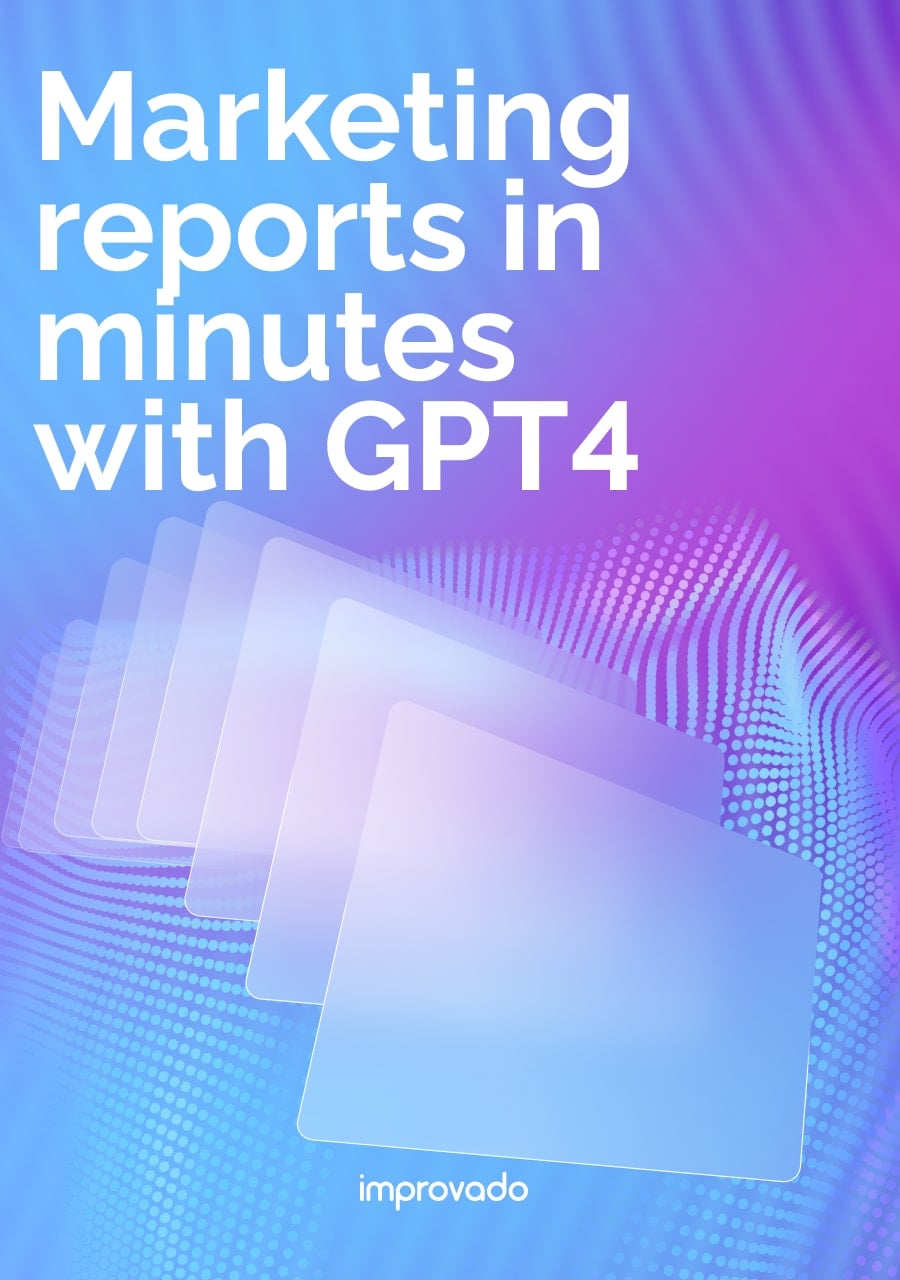Choosing the right marketing data platform can feel overwhelming. With dozens of tools promising to simplify reporting and analytics, it’s hard to know which one will actually solve your team’s challenges.
Adverity often comes up as a top contender, especially for teams looking to automate data pipelines and centralize marketing data. But before you commit, it’s important to understand what Adverity does well and where it may leave gaps.
In this article, we’ll take a closer look at Adverity’s core features, strengths, and weaknesses. We’ll also compare it to leading alternatives like Improvado, Funnel.io, Supermetrics, Whatagraph, and Tableau to help you decide if it’s the best fit for your marketing and analytics goals.
Key Takeaways
- Strengths: Adverity is highly praised for its extensive data connectors, powerful transformation capabilities, and customer support, making it a strong choice for automating marketing data pipelines.
- Weaknesses: Common user complaints include limitations in the built-in data visualization suite, occasional performance lags with large datasets, and a potentially high cost depending on the scale of operation.
- Ideal User: Adverity is best suited for mid-market to enterprise-level businesses and agencies with data engineering resources that need a flexible, customizable ETL tool to centralize complex marketing data.
- Alternative Consideration: For teams seeking an all-in-one solution with robust, AI-driven analytics and seamless BI tool integration without heavy reliance on custom scripts, alternatives like Improvado should be considered.
What is Adverity? A Quick Overview

Adverity is a data integration and analytics platform designed to centralize marketing, sales, and e-commerce data from multiple sources. It connects to a wide range of APIs, databases, and file-based inputs, automatically ingesting and harmonizing data into a unified format.
Once centralized, Adverity enables teams to create dashboards, reports, and custom data pipelines for analysis. It supports both ETL (Extract, Transform, Load) and ELT workflows, allowing users to clean and transform data either before or after it reaches a data warehouse.
The platform is commonly used to streamline reporting, improve data quality, and provide a single view of performance across channels and campaigns.
Who Is Adverity For?
Adverity is built for mid-sized to large organizations that manage complex, multi-channel data environments. It’s commonly adopted by enterprise marketing teams, agencies, and e-commerce businesses that need to integrate data from dozens or even hundreds of platforms.
The platform is designed for roles focused on analytics and data operations, including marketing analysts, data scientists, business intelligence teams, and data engineering groups.
Adverity Core Functionality
The platform's core purpose is marketing data automation:
- Data Integration: Automatically ingest data from 600+ APIs, databases, and file sources.
- Data Transformation: Cleanse, normalize, and harmonize data using built-in logic and transformation pipelines.
- Data Quality Monitoring: Detect anomalies, duplicates, volume spikes, schema drift, and trigger alerts when data deviates from expected patterns.
- Adverity Intelligence: Uses AI and conversational interfaces (Data Conversations, Notebooks) to query data in plain English and creative team reports.
- Data Governance: Maintain version control, transformation lineage tracking, and rule enforcement to ensure traceability and compliance.
- Automated Scheduling: Smart scheduling for pipeline execution and flexible refresh intervals to keep data up-to-date.
- Export, Activation, and Sharing: Push harmonized data to BI tools, data warehouses, storage systems, or downstream apps.
- Data Visualization: Build dashboards and visual reports directly within Adverity using customizable charts, KPIs, and widgets. While suited for quick insights and internal reporting, teams can also export datasets to dedicated BI tools.
Adverity Reviews: A Detailed Breakdown of User Feedback
Based on user feedback from across the web, Adverity is a highly capable data integration platform, but it’s not without its limitations. Understanding these Adverity pros and cons is crucial for determining if it’s the right fit for your organization.
The Pros: What Users Love About Adverity
Extensive Connectivity and Data Extraction
A standout feature mentioned in almost every positive Adverity review is its vast library of over 600 Adverity connectors. Users praise the platform's ability to seamlessly pull data from nearly every marketing and advertising channel, eliminating the manual work of downloading and consolidating spreadsheets.
Powerful Automation and Time-Saving Efficiency
Adverity excels at marketing data automation. Teams report significant time savings by automating data collection and scheduling fetches. This allows analysts to focus on generating insights rather than managing data pipelines.
Flexible Data Transformation Capabilities
Users appreciate the platform's data transformation module. Adverity provides a powerful, flexible environment for data enrichment, custom metric creation, and data harmonization. This allows teams to create a clean, standardized dataset tailored to their specific business logic and reporting needs.
Highly-Praised Customer Support
Adverity support is consistently highlighted as a major strength. Reviewers frequently describe the support team as responsive, knowledgeable, and a true partner in solving complex data challenges. Many users feel the support team acts as an extension of their own, providing expert guidance and quick resolutions.
The Cons: Common Criticisms and Drawbacks
Instability after Updates
Users report that new releases sometimes break existing pipelines or datastreams. That leads to emergency troubleshooting and delays in reporting workflows.
Potentially High Cost and Complex Pricing
Adverity pricing is often cited as a significant consideration, particularly for agencies or smaller businesses. The pricing model can be complex and may become costly as data volume or the number of connectors increases. Several reviews mention that the investment requires a clear ROI calculation to be justifiable.
Data Errors or Failures in Fetch and Pipeline Execution
Some pipelines fail, data fetches time out, or runs get interrupted, causing gaps or delays in metrics.
Additionally, the platform can experience performance lags when processing very large or complex datasets, slowing down transformation and load times.
Limited Built-in Visualization Capabilities
A primary drawback noted in Adverity reviews is that it is not a comprehensive BI or visualization tool. While it offers some dashboarding features, they are basic compared to dedicated BI platforms. This means most teams must pipe their data into a separate tool for any meaningful analysis or reporting.
Steeper Learning Curve for Advanced Features
While basic data connections are straightforward, mastering Adverity's advanced transformation and scripting capabilities presents a steeper learning curve. Unlocking the platform's full potential often requires a dedicated user with technical skills, which may be a barrier for teams without specialized data talent.
Overall Adverity Strengths vs. Weaknesses
| Strengths of Adverity | Weaknesses of Adverity |
|---|---|
| Wide range of connectors (600+ integrations) | Instability after updates or version changes |
| Strong data transformation and normalization tools | Data fetch failures and occasional crashes |
| Cloud-based ELT workflows for scalability | Steep learning curve for advanced features |
| Automated data quality checks and alerts | Limited visualization and exploration depth |
| AI-driven analytics with Adverity Intelligence | Missing or incomplete connectors for some regions |
| Role-based permissions and governance features | Lack of robust dev vs. production environment support |
| Flexible scheduling and smart syncs | Irreversible mistakes and no version rollback |
| Native dashboards for quick reporting | Difficult error tracing and troubleshooting |
How Does Adverity Compare to Top Alternatives?
When evaluating Adverity alternatives, it's important to distinguish between pure-play ETL tools and all-in-one marketing intelligence platforms.
The table provides a brief overview of the top Adverity alternatives, in the section below we will take a closer look at each platform.
| Tool | Best for |
|---|---|
| Adverity | Enterprise teams with strong in-house data expertise looking for a flexible ETL platform to centralize marketing data and feed external BI tools for custom analytics. |
| Supermetrics | Small to mid-sized teams needing a lightweight, connector-focused solution for pulling data into spreadsheets or visualization tools. |
| Improvado | Mid-market to enterprise companies seeking a full-stack marketing intelligence platform with robust ETL, pre-built models, automated governance, and AI-driven analytics. |
| Funnel.io | Marketing teams needing a mid-tier ETL solution with simplified transformations and standard reporting outputs, without deep customization or advanced analytics. |
| Whatagraph | Small to mid-sized teams looking for easy-to-use automated marketing reports and dashboards, with limited transformation or data modeling capabilities. |
| Tableau | Organizations with robust data pipelines already in place that need a powerful BI tool for visualization, exploration, and advanced data storytelling. |
Adverity vs. Supermetrics
Adverity and Supermetrics both focus on marketing data integration but cater to very different use cases and organizational needs.
Adverity is designed for mid-market to enterprise companies that manage complex, multi-source marketing and sales data across global teams. It offers advanced features like data quality monitoring, AI-driven insights, automated transformations, and governance controls, making it well-suited for organizations with strict compliance needs and multi-brand reporting at scale.
Supermetrics, on the other hand, is a lightweight tool primarily focused on data extraction. It’s popular among smaller teams and agencies that need to quickly pull data from marketing platforms into spreadsheets or BI tools. While it provides an affordable way to centralize data for basic reporting, it lacks the advanced transformation logic, automation, and governance needed for enterprise-scale operations.
| Feature | Adverity | Supermetrics |
|---|---|---|
| Target Audience | Mid-market to enterprise companies with complex data stacks | Small businesses, agencies, and teams needing simple reporting |
| Data Sources | 600+ connectors across marketing, sales, and e-commerce platforms | ~100 connectors focused mostly on marketing data |
| Transformation | Built-in ETL/ELT with custom logic and advanced normalization | Basic field mapping, mostly direct data extraction |
| Governance | Role-based access, audit trails, version control | Limited governance features |
| Automation | Automated scheduling, anomaly detection, and AI-driven monitoring | Manual scheduling with basic automation |
| Data Quality | Advanced Data Monitor with custom and universal checks | Minimal validation, dependent on source data accuracy |
| Visualization | Native dashboards plus integration with BI tools | No native visualization, relies on external tools like Google Sheets or Data Studio |
| Scalability | Built for high-volume, multi-brand, global deployments | Best for smaller, single-team use cases |
| Pricing | Higher cost, enterprise-grade subscription model | Lower cost, flexible plans for smaller teams |
Adverity vs. Improvado
Adverity and Improvado are both designed to solve the challenges of marketing data management at scale, but they approach the problem from different angles and with varying levels of specialization.
Improvado is purpose-built for enterprise-level marketing analytics and governance. It provides 500+ pre-built connectors but focuses deeply on marketing-specific needs such as advanced attribution, real-time metric and budget pacing, cross-channel metric harmonization, and data compliance at scale.
Similar to Adverity, Improvado provides AI-powered transformation assistance to automate data preparation, anomaly detection, and KPI modeling, as well as AI Agent for natural language querying and AI report and dashboard generation.
| Feature | Adverity | Improvado |
|---|---|---|
| Target Audience | Mid-market to enterprise companies needing centralized marketing and sales analytics | Enterprise-grade brands and agencies managing multi-brand, global marketing data operations |
| Data Sources | 600+ connectors | 500+ connectors |
| Transformation | Built-in ETL/ELT pipelines with data modeling, mapping, and custom transformation logic | Built-in ETL with AI-driven transformations, pre-built data models for unified, harmonized marketing metrics |
| Governance | Role-based permissions, audit trails, and basic governance controls | Comprehensive marketing governance inc. role-based permissions, audit trails, naming conventions, lineage tracking, and metric pacing |
| Automation | Automated scheduling, anomaly alerts, and workflow orchestration | Proactive anomaly detection and campaign naming conventions enforcement |
| Visualization | Native dashboards and data exploration with Adverity Intelligence (AI-powered analytics assistant) | Generative AI dashboards and seamless integration with BI tools like Tableau or Power BI |
- Choose Adverity if: You already have a mature data stack with a data warehouse and a BI tool you love. Your primary need is to automate the data pipeline feeding into that system, and you have a technical team to manage the analytics downstream.
- Choose Improvado if: You need a single source of truth for marketing performance. Your goal is to not only centralize data but also to analyze, visualize, and get actionable insights from it within one platform, without heavy reliance on IT or data science teams.
Adverity vs. Funnel.io
Adverity vs Funnel.io are both platforms focused on marketing data integration, but they serve different segments of the market and emphasize distinct capabilities.
Adverity is a comprehensive platform built for companies that need more than just data collection. It combines advanced ETL/ELT functionality, quality checks, and built-in analytics via Adverity Intelligence.
Funnel, on the other hand, focuses on speed and simplicity. It specializes in extracting and harmonizing marketing data from 500+ sources, then pushing it to destinations like spreadsheets, BI platforms, or data warehouses.
Funnel.io is lightweight and easy to deploy, which makes it well-suited for marketing teams or agencies that want to automate reporting workflows quickly but don’t need advanced governance, compliance, or integrated analytics capabilities.
| Feature | Adverity | Funnel.io |
|---|---|---|
| Target Audience | Mid-market to enterprise companies needing integrated analytics and governance | Marketing teams and agencies needing simple, automated data pipelines |
| Data Sources | 600+ connectors | 500+ connectors |
| Transformation | Full ETL/ELT workflows | Basic normalization and cleaning before export |
| Governance | Role-based access, audit trails, and built-in compliance features | Limited governance controls; relies on external tools |
| Automation | Automated workflows with anomaly detection and Data Monitor alerts | Automated syncing and scheduling focused on data extraction |
| Visualization | Native dashboards and AI-driven analysis via Adverity Intelligence | No native analytics/visualization; designed for external BI integrations |
Adverity vs. Whatagraph
Adverity and Whatagraph address different needs in the marketing data lifecycle, with one focused on advanced data management and analytics, and the other on simplified reporting and visualization.
Whatagraph specializes in streamlined automated reporting and visualization for marketing agencies and in-house teams. Its main strength lies in quickly pulling data from various marketing platforms and displaying it in customizable, client-friendly dashboards.
Whatagraph excels at speed and usability, allowing non-technical users to generate reports without complex setup. However, it lacks the deeper data transformation, governance, and analytics capabilities found in Adverity, making it better suited for teams focused on straightforward reporting rather than enterprise-grade data management.
| Feature | Adverity | Whatagraph |
|---|---|---|
| Target Audience | Mid-market to enterprise companies with complex, multi-source data needs | Marketing agencies and small to mid-sized teams needing fast, easy reporting |
| Data Sources | 600+ connectors | 40+ connectors |
| Transformation | Full ETL/ELT workflows with advanced mapping and harmonization | Limited transformation; mostly direct data pulls for reporting |
| Automation | Workflow automation with anomaly detection and Data Monitor alerts | Scheduled report generation and delivery |
| Visualization | Native dashboards and AI-driven analytics via Adverity Intelligence | Client-ready visual reports with templates and drag-and-drop customization |
| Scalability | Built for global, high-volume, multi-brand enterprise deployments | Best for smaller teams or agencies with straightforward reporting needs |
Adverity vs. Tableau
Adverity and Tableau serve very different purposes in the data ecosystem, often complementing rather than replacing each other.
Adverity’s strength lies in centralizing and preparing data for analysis, ensuring consistency, accuracy, and compliance across global campaigns before it reaches BI or analytics tools.
Tableau, by contrast, is a leading business intelligence and data visualization platform. It specializes in turning prepared data into highly interactive dashboards, reports, and advanced visual analytics.
Tableau does not extract, clean, or transform raw marketing data natively. Instead, it consumes processed, analytics-ready datasets from platforms like Adverity or data warehouses. While Tableau excels in exploration, visualization, and self-service analytics, it relies on external tools for data ingestion, transformation, and quality control.
| Feature | Adverity | Tableau |
|---|---|---|
| Primary Purpose | Data integration, transformation, and marketing data governance | Data visualization, exploration, and interactive dashboarding |
| Data Sources | 600+ connectors across marketing, sales, and e-commerce platforms | Connects to warehouses, prepared datasets, and third-party tools; limited direct API integrations |
| Transformation | Full ETL/ELT workflows with modeling, harmonization, and quality checks | Minimal native transformation; relies on clean, structured data |
| Automation | Automated workflows, anomaly detection, and scheduling via Data Monitor | Automation for report refreshes and scheduled dashboard delivery |
| Visualization | Basic native dashboards; designed to feed external BI tools for advanced visualization | Industry-leading visual analytics, drilldowns, and storytelling features |
Key Considerations Before Choosing Adverity
Before committing to Adverity, evaluate your organization’s analytics maturity and long-term goals. Use these three critical questions to determine whether Adverity is the right fit.
Do you have an existing BI or visualization tool?
Adverity is designed to act as a data pipeline and transformation layer, not a primary visualization platform. If your team is already proficient with tools like Tableau, Looker, or Power BI, Adverity can seamlessly feed them with clean, harmonized marketing data. This allows you to maintain your current reporting workflows while solving data integration challenges.
If you don’t have a BI tool in place, you’ll need to factor in the additional cost, technical implementation, and user training required to deploy one before realizing value from Adverity.
How much control do you need over marketing analytics?
Adverity excels at centralizing and standardizing raw data but stops short of providing analytics frameworks or decision-ready insights. This gives you maximum flexibility to build custom attribution models, dashboards, and analyses but it requires significant internal resources and expertise.
If your team lacks data engineering capacity or needs pre-built marketing models for attribution, ROI measurement, and campaign optimization, a more opinionated platform like Improvado may reduce time-to-insight and reliance on in-house data science teams.
Is your primary goal ETL or comprehensive performance analysis?
If your top priority is reliable, automated data collection and transformation across multiple marketing sources, Adverity is a good choice for ETL.
However, if you need to go beyond integration, building cross-channel performance reports, proving marketing ROI to executives, and generating proactive recommendations, consider a more comprehensive marketing intelligence platform. This type of solution delivers both the infrastructure for data management and the analytical layer required to accelerate decision-making and revenue impact.
The Verdict: Is Adverity Worth It in 2025?
Adverity is undoubtedly a powerful and valuable data integration platform for the right company.
However, for marketing and revenue teams looking for an end-to-end solution that provides not just data, but answers, Adverity’s limitations in native analytics and visualization are significant.
The need to pair it with other tools adds complexity and cost, making all-in-one Adverity competitors like Improvado a more efficient and insightful choice for businesses focused on comprehensive performance analysis.
Ultimately, the decision comes down to your primary goal. If you need a reliable data pipeline tool, Adverity is worth the investment. If you need a unified platform for marketing intelligence, you should explore more holistic alternatives.
.png)



.png)
